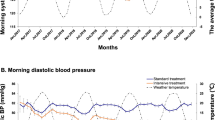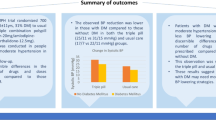Abstract
Current antihypertensive strategies do not take into account that individual characteristics may influence the magnitude of blood pressure (BP) reduction. Guidelines promote trial-and-error approaches with many different drugs. We conducted the Identification of the Determinants of the Efficacy of Arterial blood pressure Lowering drugs (IDEAL) Trial to identify factors associated with BP responses to perindopril and indapamide. IDEAL was a cross-over, double-blind, placebo-controlled trial, involving four 4-week periods: indapamide, perindopril and two placebo. Eligible patients were untreated, hypertensive and aged 25–70 years. The main outcome was systolic BP (SBP) response to drugs. The 112 participants with good compliance had a mean age of 52. One in every three participants was a woman. In middle-aged women, the SBP reduction from drugs was −11.5 mm Hg (indapamide) and −8.3 mm Hg (perindopril). In men, the response was significantly smaller: −4.8 mm Hg (indapamide) and −4.3 (perindopril) (P for sex differences 0.001 and 0.015, respectively). SBP response to perindopril decreased by 2 mm Hg every 10 years of age in both sexes (P=0.01). The response to indapamide increased by 3 mm Hg every 10 years of age gradient in women (P=0.02). Age and sex were important determinants of BP response for antihypertensive drugs in the IDEAL population. This should be taken into account when choosing drugs a priori.
This is a preview of subscription content, access via your institution
Access options
Subscribe to this journal
Receive 12 digital issues and online access to articles
$119.00 per year
only $9.92 per issue
Buy this article
- Purchase on Springer Link
- Instant access to full article PDF
Prices may be subject to local taxes which are calculated during checkout



Similar content being viewed by others
References
Mancia G, Laurent S, Agabati RE, Ambrosioni E, Burnier M, Caufield MJ et al. Reappraisal of European guidelines on hypertension management: a European Society of Hypertension Task Force document. J Hypertens 2009; 27: 2121–2158.
Diao D, Wright JM, Cundiff DK, Gueyffier F . Pharmacotherapy for mild hypertension. Cochrane Database Syst Rev 2012; 8 (Art. No.): CD006742.
Hansson L, Zanchetti A, Carruthers SG, Dahlhöf B, Elmfeldt D, Julius S et al. Effects of intensive blood-pressure lowering and low-dose aspirin in patients with hypertension: principal results of the Hypertension Optimal Treatment (HOT) randomised trial. Lancet 1998; 351: 1755–1762.
Boissel JP, Gueyffier F, Boutitie F, Pocock S, Fagard R . Apparent effect on blood pressure is only partly responsible for the risk reduction due to antihypertensive treatments. Fund Clin Pharmacol 2005; 19: 579–584.
Staessen JA, Wang JG, Thijs L . Cardiovascular protection and blood pressure reduction: a meta-analysis. Lancet 2001; 358: 1305–1315.
Verdecchia P, Reboldi G, Angeli F, Gattobigio R, Bentivoglio M, Thijs L et al. Angiotensin-converting enzyme inhibitors and calcium channel blockers for coronary heart disease and stroke prevention. Hypertension 2005; 46: 386–392.
Wu Y, Li YS, Bejan-Angoulvant T, Gueyffier F . Modeling of systolic blood pressure reaction to antihypertensive agents in people with hypertension. Zhonghua Xin Xue Guan Bing Za Zh, i 2011; 39: 309–314.
Bejan-Angoulvant T, Baguet JP, Erpeldinger S, Boivin JM, Mercier A, Leftheriotis G et al. The IDEAL study: towards personalized drug treatment of hypertension. Therapie 2012; 67: 1–10.
Materson BJ, Reda DJ, Cushman WC . Department of Veterans Affairs single-drug therapy of hypertension study. Revised figures and new data. Department of Veterans Affairs Cooperative Study Group on Antihypertensive Agents. Am J Hypertens 1995; 8: 189–192.
Attwood S, Bird R, Burch K, Casadei B, Coats A, Conway J et al. Within-patient correlation between the antihypertensive effects of atenolol, lisinopril and nifedipine. J Hypertens 1994; 12: 1053–1060.
Dickerson JEC, Hingorani AD, Ashby MJ, Palmer CR, Brown MJ . Optimisation of antihypertensive treatment by crossover rotation of four major classes. Lancet 1999; 353: 2008–2013.
Hiltunen TP, Suonsyrjä T, Hannila-Handelberg T, Paavonen KJ, Miettinen HE, Strandberg T et al. Predictors of antihypertensive drug responses: initial data from a placebo-controlled, randomized, cross-over study with four antihypertensive drugs (the GENRES Study). Am J Hypertens 2007; 20: 311–318.
Suonsyrjä T, Hannila-Handelberg T, Paavonen KJ, Miettinen HE, Donner K, Strandberg T et al. Laboratory tests as predictors of the antihypertensive effects of amlodipine, bisoprolol, hydrochlorothiazide and losartan in men: results from the randomized, double-blind, crossover GENRES Study. J Hypertens 2008; 26: 1250–1256.
Suonsyrjä T, Donner K, Hannila-Handelberg T, Fodstad H, Kontula K, Hiltunen TP . Common genetic variation of b1- and b2-adrenergic receptor and response to four classes of antihypertensive treatment. Pharmacogenet Genomics 2010; 20: 342–345.
Law MR, Wald NJ, Morris JK, Jordan RE . Value of low dose combination treatment with blood pressure lowering drugs: analysis of 354 randomised trials. BMJ 2003; 326: 1427.
Riley RD, Lambert PC, Staessen JA, Thijs L, Wang J, Gueyffier F et al. Combining individual patient data and aggregate data in meta-analysis of continuous outcomes. Stat Med 2008; 28: 1870–1893.
Bell KJL, Hayen A, Macaskill P, Craig JC, Neal BC, Fox KM et al. Monitoring initial response to angiotensin-converting enzyme inhibitor_based regimens. An individual patient data meta-analysis from randomized, placebo-controlled trials. Hypertension 2010; 56: 533–539.
Acknowledgements
IDEAL Trial results contribute to the success of the BIMBO ANR project (SYSCOMM 2008-002). We are grateful to Servier who gave us the drugs and dosages of indapamide and N-acetyl-Ser-Asp-Lys-Pro. Servier was not involved in study conduct or data analysis. We thank Kent Neal (supported by the French Cochrane Centre) for proofreading and editing the manuscript. The IDEAL Trial was made possible thanks to a grant from the French Society of Hypertension and from the 2003 French Hospital Program for Clinical Research (D50327).
Members of the IDEAL Trial Group
The IDEAL Trial Group is made up of: Yishi Li (Key Laboratory of Clinical Trial Research in Cardiovascular Drugs, Ministry of Health, Fuwai Cardiovascular Hospital, Beijing, China); Calin Pop (Faculty of Medicine, Arad, Western University Vasiel Goldis; Cardiology, Regional Hospital, BaieMare, Romania); Salam Farhat (Claude Bernard Lyon 1 University, Lyon, France); Alain Richet (Claude Bernard Lyon 1 University, Lyon, France); Marie-France Le Goaziou (Claude Bernard Lyon 1 University, Lyon, France); Rojee Neguib (Claude Bernard Lyon 1 University, Lyon, France); Marie Flori (Claude Bernard Lyon 1 University, Lyon, France); Pierre Lantelme (Cardiology, Croix Rousse Hospital, Lyon, France); Denis Angoulvant (Cardiology, Louis Pradel Hospital, Lyon, France); Pierrette Darchy (Cardiology, Louis Pradel Hospital, Lyon, France); Stéphane Laurent (Pharmacology, Pompidou European Hospital, Inserm and Paris Descartes University, Paris, France); Faiez Zannad (Cardiology Departement, Nancy University, Nancy, France); Patrick Rossignol (Nancy University and Inserm CIC, Nancy, France); Anne-Françoise Cailleux (Rouen University Hospital, Inserm CIC, Rouen, France); Christian Libersa (CIC, Inserm and CHU, Lille, France); Atul Pathak (Clinical Pharmacology, Toulouse University; Inserm; Federation of Cardiology, Toulouse, France); Jean-Michel Halimi (Nephrology, Bretonneau Hospital, Tours, France); Jacques Amar (Inserm, Faculty of Medicine, Toulouse, France); Xavier Jeunemaitre (Department of Genetics, Pompidou European Hospital, Inserm-PARCC, Paris, France); Michel Azizi (Clinical Center of Investigations, Pompidou European Hospital, Paris, France); Florent Boutitie (Department of Biostatistics, Hospices Civils de Lyon; CNRS, Villeurbanne, France).
Author information
Authors and Affiliations
Consortia
Corresponding author
Ethics declarations
Competing interests
The authors declare no conflict of interest.
Rights and permissions
About this article
Cite this article
Gueyffier, F., Subtil, F., Bejan-Angoulvant, T. et al. Can we identify response markers to antihypertensive drugs? First results from the IDEAL Trial. J Hum Hypertens 29, 22–27 (2015). https://doi.org/10.1038/jhh.2014.29
Received:
Revised:
Accepted:
Published:
Issue Date:
DOI: https://doi.org/10.1038/jhh.2014.29
This article is cited by
-
Estrogen-mediated mechanisms in hypertension and other cardiovascular diseases
Journal of Human Hypertension (2022)



